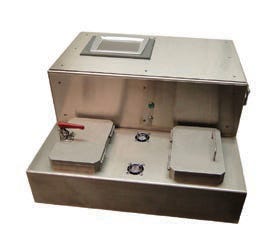December 6, 2010
|
The Trace900 blister-pack tester employs tracer gases to detect package leaks. |
For decades, leak-test technologies have relied on either immersing a package in a vacuum water bath or subjecting it to a pressure-decay and mass-flow test. But because these methods can result in wasted product or generate inconclusive data, nuvoTrace has developed a different approach for its Trace900 system: the use of a tracer gas to detect package leaks.
The tracer gas used in the Tracer900 system is helium. "Helium has proved to be a fast and easy way to determine leak tightness, with the added benefit of allowing manufacturers to locate the source of the leak," explains Rich Mizia, nuvoTrace's business development manager. "We also use helium to test all types of packages, except for challenging, nonwoven, flash-spun materials such as Tyvek."
The Trace900 system contains a bombing chamber and a test chamber. In the bombing chamber, a vacuum creates a negative pressure in a leaking bag or package. The chamber is then pressurized with helium, causing it to fill the potentially leaking sample with the tracer gas. After a set period of time, the chamber is evacuated, and the operator removes the sample to the test chamber. Closing the lid of the test chamber automatically starts the next cycle, which begins by drawing a small amount of air from the chamber. If gas has been trapped in the sample, it is expelled from the bag by the air and then detected by a non-mass spectrometer detector. A preset reject level determines whether a sample passes or fails.
"Package testing is still stuck in the 'wet test' rut," Mizia remarks. Most testing, for example, depends on dunking the sample in a vacuum water bath. Widely employed to test packages containing such medical devices as catheters, dunking involves the use of plain or dye-colored water, enabling the operator to track the formation of bubbles caused by a leak path. If a leak is present, the vacuum causes a pressure differential in the pack. Allowing the pack to return to atmospheric pressure causes the water to be pulled back into the pack. Besides its low production rate, this method requires operators to handle wet product, according to Mizia.
Products such as ostomy bags, medicine-fill bags, and respiratory-care products, on the other hand, rely on the pressure-decay and mass-flow technique. The problems with this technology are manifold, according to Mizia. "For flexible products, the time required for the pressure in the bag to decay prolongs the test process," he says. "Also, because products shift as pressure increases, bags must be stabilized before a correct pressure reading is possible." Furthermore, he adds, the process of stabilization can appear to be a leak because of the subsequent pressure drop.
"One of the advantages of our system is that it is nondestructive," Mizia comments. "Positively tested bags go back into the production line in preparation for shipping, while failed bags can be removed from the line and their contents can be repackaged. The only thing you need to destroy is the packaging."
nuvoTrace
Las Vegas
www.nuvotrace.com
You May Also Like



